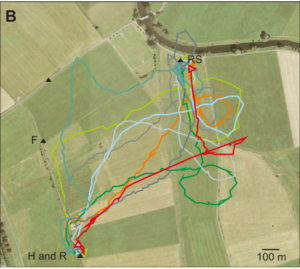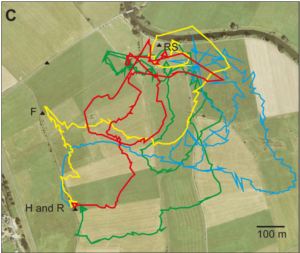I thought I had posted this link to research – however I’m not finding it at the moment – so I will post it again – in light of this winters’ reported massive honeybee losses by commercial beekeepers. (as noted in my last post). While the symptoms and possible causes are being investigated – I would like to remind folks that we’ve known for a while that poisons affect honeybees negatively.
In 2015, a research article was published in the Journal of Experimental Biology – that plotted the flight paths of honeybees foraging – before and after “sublethal” doses of glyphosate ( aka Roundup). The published work of María Sol Balbuena, Léa Tison, Marie-Luise Hahn, Uwe Greggers, Randolf Menzel, and Walter M. Farina is available at the link below – it is an interesting read – and is eye-opening to the measured effects of poisons on the neurological system of honeybees as related to flight navigation. With no exposure, the bees’ flight paths are very direct. With low exposures (ingested) the flight paths become erratic… and with higher doses (but still “sublethal”) – their flight paths are all over – and the bees had a hard time making it back to the hives.
From the abstract:
We performed an experiment in which forager honeybees were trained to an artificial feeder, and then captured, fed with sugar solution containing traces of GLY and released from a novel site either once or twice. Their homeward trajectories were tracked using harmonic radar technology. We found that honeybees that had been fed with solution containing 10 mg l−1 GLY spent more time performing homeward flights than control bees or bees treated with lower concentrations. They also performed more indirect homing flights. Moreover, the proportion of direct homeward flights performed after a second release from the same site increased in control bees but not in treated bees. These results suggest that, in honeybees, exposure to levels of GLY commonly found in agricultural settings impairs the cognitive capacities needed to retrieve and integrate spatial information for a successful return to the hive. Therefore, honeybee navigation is affected by ingesting traces of the most widely used herbicide worldwide, with potential long-term negative consequences for colony foraging success.
The images below are from their research – and show:
Examples of homeward flights made by honeybees during the first release after treatment. Flight paths were categorized as direct (A), single-loop (B) or indirect (C). Colors: light blue and red for control bees, blue and orange for bees treated with 2.5 mg l−1 glyphosate (GLY), yellow and lilac for bees treated with 5 mg l−1 GLY, and green and gray for bees treated with 10 mg l−1 GLY. H, hive; R, radar; F, feeder; RS, release site.




Leave a Reply
You must be logged in to post a comment.